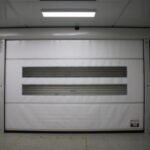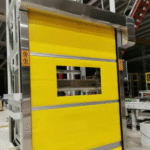Cleanroom Door
Why Not Use a Regular Door?
Clean Room Door Standard doors, while adequate for everyday environments, are ill-suited for cleanrooms. Tiny gaps around hinges and frames, the potential for warping, and materials that shed particles all pose serious contamination risks. In a cleanroom, where even the smallest imperfection can cause major issues, these flaws become unacceptable.
What Makes a Door Cleanroom-Grade?
Cleanroom doors are engineered to strict standards and include features specifically designed to maintain the sterile, particle-free environment inside:
1. Airtight Sealing – The Most Crucial Feature
- Gasketing: High-quality, non-shedding gaskets (often made from silicone or EPDM rubber) surround the door edges, forming a tight seal.
- Precision Fit: Doors are manufactured with extremely tight tolerances to eliminate air leaks and maintain pressure differentials.
2. Non-Shedding, Clean-Compatible Materials
- Stainless Steel: Corrosion-resistant and easy to sanitize.
- Powder-Coated Steel or Aluminum: Offers a smooth, durable, and non-porous surface.
- HPL (High-Pressure Laminate): Often used over a solid core for a smooth and chemically resistant finish.
- Specialty Plastics: Applied in specific applications for their non-reactive and lightweight properties.
Porous and particle-shedding materials such as wood and traditional paint are strictly avoided.
3. Smooth and Seamless Surfaces
Cleanroom doors feature smooth, easy-to-clean surfaces with flush-mount designs. These prevent dust accumulation and make sanitation efficient, supporting strict hygiene protocols.
4. Durability and Chemical Resistance
These doors withstand frequent cleaning and high usage without degrading. They’re designed to last and maintain performance over time, even under rigorous sanitization procedures.
Special Features of Cleanroom Doors
1. Interlocking Systems for Airlocks
In high-grade cleanrooms, interlock systems are used to prevent simultaneous opening of adjacent doors. This controls air exchange and maintains internal cleanliness.
- Magnetic Interlocks: Electrically controlled to ensure sequential access.
- Visual Indicators: Signal door status to prevent errors and improve safety.
2. Viewing Panels
Flush-mounted tempered glass or polycarbonate windows allow visibility without compromising the cleanroom seal. They help reduce unnecessary door openings and support safer operations.
Types of Cleanroom Doors
Different cleanroom zones and applications call for specific types of doors:
- Hinged/Swing Doors: Most common; ideal for personnel entry/exit.
- Sliding Doors: Space-saving; suitable for wide openings and equipment transfer.
- Bi-Parting Doors: Two sliding panels meeting in the center; used for larger access points.
- Roll-Up/High-Speed Doors: Ideal for frequent access areas, material transfer zones, or entry to clean zones in pharmaceutical and food industries.
The Importance of Pressure Differentials
Cleanrooms often operate under positive pressure compared to surrounding areas. When a door opens, this pressure forces air out, preventing contaminants from entering. Once closed, the door must maintain this pressure to preserve the room’s cleanliness — hence, a perfect seal is essential.
Conclusion
Cleanroom doors are much more than entryways — they are integral components of a highly controlled environment. Their engineered design, durable materials, and sealing capabilities ensure the containment of cleanliness and the exclusion of contaminants.
In industries like pharmaceuticals, electronics, biotechnology, and aerospace, cleanroom doors play a critical role in protecting products, processes, and people. They are the silent guardians of sterile spaces, ensuring that the high standards of purity and precision are upheld with every close and open.
Whether in a high-tech lab or a pharmaceutical facility, the cleanroom door is a symbol of precision and performance — a true unsung hero of modern contamination control.



